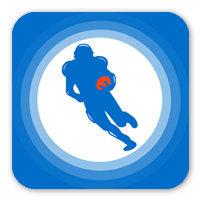Kyle's overvalued fantasy football running backs busts. His top starting RB busts set to fall short of ADP, including Chuba Hubbard and more. Avoid these workhorse backs: Chubba Hubbard, Tony Pollard, D’Andre Swift, and more.
Running backs tend to be the most fragile position in fantasy football year after year, except for last season. It was an outlier year for running back health, as only three running backs in the consensus top-24 ADP missed more than three games from injury. It’s quite difficult to predict injury, and no one wants that to happen, but it’s a reality of the position.
There are a number of ways for workhorse backs to bust in the case of not getting injured. You see it often where we project an inefficient back for plenty of touches, but his talent isn’t good enough to hold onto the spot, or the upside just isn’t there. Some are in offensive environments that limit the ceiling or don’t receive enough of the high-value touches that we yearn for in fantasy football, and of course, some are just overpriced at their ADP.
We’ll look at a handful of potential bust candidates at the running back position for 2025. Each workhorse back here was in the top 20 in overall rush attempts last season. Players could be labeled as a “bust” here, and produce plenty of points but lack that legendary upside. We will be using ESPN’s ADP for 1QB, PPR formats.
Featured Promo: New Novig users get a $25 purchase match (50% discount up to $25) on your first Novig deposit, and 3 free months of RotoBaller's "Big-4" Premium Pass (NFL, NBA, MLB, NHL) which includes exclusive tools for Betting, Props, DFS and more! CLAIM IT NOW
Josh Jacobs (17 ADP | RB9 | ESPN)
Jacobs is coming off an impressive season in his first year in Green Bay, totaling 1,329 rushing yards while chipping in 342 receiving yards and scoring 16 total touchdowns. He finished as the RB6 in PPR formats, averaging 17.2 points per game. The 27-year-old was relied on heavily with a whopping 358 total touches between the regular season and playoffs, and he was pretty efficient with 4.4 yards per carry and a career best eight yards per target, which was one of the best marks among all running backs. The advanced metrics were favorable as well, with 2.9 yards after contact per attempt and a 24.6% Avoided Tackle%, per FTN Fantasy.
Some contextual elements were playing in Jacobs’ favor in 2024, with a lack of real competition for touches as well as Jordan Love spraining his MCL in week 1 last season and managing that throughout the year. While he was fully expected to be the Packers’ workhorse after signing a 4-year $48 million contract, they also invested a third-round pick into MarShawn Lloyd, who dealt with a myriad of injuries starting in training camp and ended up only playing 10 snaps all season.
While it doesn’t mean everything, the contracts are very similar between Jacobs and the extension that Aaron Jones signed with the Packers a few years ago. It was the same AAV at $12 per season, and Jones narrowly edged him out in guaranteed money ($13 million for Jones vs. $12.5 million for Jacobs). Jacobs and his size are better built to handle a full workload than Jones, but the contractual element is a small piece to consider here.
It’s noteworthy to bring up Lloyd, as historically, head coach Matt LaFleur likes to use two running backs. Lloyd has an exciting prospect profile, showcasing explosiveness, as he averaged 7.1 yards per carry in his final college season at USC, tied for the fourth-highest among all running backs per PFF (min. 100 rushes).
While his raw receiving production wasn’t gaudy, he was incredibly efficient after the catch, also with 17.8 yards per reception. Additionally, there’s already been some positive coachspeak from LaFleur this offseason talking about how his skill set is different from the other backs in the room and has the explosiveness to be a dynamic weapon when he is healthy. As mentioned with LaFleur, he has a history of using multiple backs, so even players like Emanuel Wilson and Chris Brooks should see some runs.
Wonder if MarShawn Lloyd could have a bit larger role than expected in 2025
(Note that A-aron only played 11 games in 2023) pic.twitter.com/4sRBzU6xVO
— Ian Hartitz (@Ihartitz) May 20, 2025
A good read on MarShawn Lloyd and the Green Bay Packers RB2 battle.
Lloyd is my bet to win the direct handcuff job behind Josh Jacobs. This could be a very valuable role based on the volume Jacobs had last season and run heavy Packers offense. pic.twitter.com/Lu7nHHXebO
— Theo Gremminger (@TheOGfantasy) July 14, 2025
The Love injury to begin the season likely played a pretty sizable role in Green Bay’s pass rate cratering last year. In the LaFleur era, they’ve typically been average to slightly above average in pass rate and pass rate over expected. He’s never leaned into the pass super heavily, even with Aaron Rodgers, but 2024 is an outlier compared to the other seasons.
| Year | Pass Rate | PROE |
| 2019 | 63% | 3% |
| 2020 | 58% | 3% |
| 2021 | 61% | 4% |
| 2022 | 58% | -3% |
| 2023 | 61% | 1% |
| 2024 | 51% | -8% |
So the pass rate should be expected to creep back towards the 60% mark as Love is back to full health, which will reduce the overall number of carries for Jacobs. In addition, the Packers were the second-most pass-heavy team in the red zone in Love’s first year as a starter. With him banged up, they dipped down to 11th in raw pass attempts in the red zone.
Targets to the running backs won’t be a huge piece of the Packers offense either, as Love is a high aDOT passer who will take risks and push the ball downfield. Jacobs has never really been known for his receiving game ability, as he’s more of a high success rate, between-the-tackles guy who will create plenty of yards after contact, but lacks the juice to create those long breakaway runs. In terms of touch distribution between rush attempts and receptions, Jacobs ranked near the top in rushing volume.
| Player | ADP | Rush % | Receiving % |
| Derrick Henry | 12 | 94.48% | 5.52% |
| Jonathan Taylor | 14 | 94.39% | 5.61% |
| Saquon Barkley | 3 | 91.27% | 8.73% |
| Kyren Williams | 23 | 90.29% | 9.71% |
| Josh Jacobs | 17 | 89.32% | 10.68% |
It is certainly possible that the offense is just much better and is more dynamic under a fully healthy Love, along with the addition of first-round wideout Matthew Golden to stretch the defense vertically. Jacobs could stand to benefit from that role, as he is a highly effective goal-line back. He led the league in rush attempts inside the 10-yard line with 40, with the next closest being Bijan Robinson at 34.
His touchdown equity is already very strong, so how much more value can be squeezed out here? He isn’t an explosive or overly efficient back; he doesn’t catch a ton of balls; and there looks to be real competition in the backfield this season. His yards per target had never topped 6.3 in any season before last year, when it jumped to 8.0.
So there is a good probability that falls back more in line with his career norm. If Lloyd looks good early and is dynamic with his touches, he can eat his way into a larger role. Still only 27 years old, Jacobs can hit where he is being drafted, but it’s a limited ceiling. We’re all about upside in fantasy football, and Jacobs is more of a volume play at this stage.
Alvin Kamara (ADP 41 | RB17 | ESPN)
Fading Alvin Kamara last season did not work out for many, including me. He finished as the RB9 overall. Under Kyle Shanahan disciple Klint Kubiak as offensive coordinator, Kamara recorded the most touches of his career with 296 touches. His run scheme enabled Kamara to have his highest yards per carry since his monster 2020 campaign, although it was still only at 4.2.
With the heavy volume, his efficiency metrics did get back to a respectable level last year. But he now enters his age 30 season, and there is a ton of uncertainty with what the Saints offense will look like under new head coach Kellen Moore.
The uncertainty begins with who will be under center for the bulk of the season for New Orleans. It is likely to be 40th overall pick Tyler Shough, who showed a tendency to push the ball down the field in college with an aDOT over 9 in the seasons where he played a good chunk of time.
There are some reasons to be concerned with the 25-year-old rookie, as he had more turnover-worthy throws than big-time throws before his final season in college, per PFF. His final season was productive, as he was significantly older than his competition.
Kamara’s peripherals have been in decline over the last few years, with his fantasy production propped by an elite receiving profile. But what will the target volume look like now that Derek Carr retired? Carr was one of the most checkdown-happy QBs in the NFL during his time, and there are questions of how Shough will be able to handle the speed of the NFL and be able to get to his checkdown often enough.
To speak to his gaudy receiving volume last season, he was tied with De'Von Achane among running backs with nine games of at least five receptions. The next closest group of backs was tied with six.
The target competition is really thin outside of Chris Olave and Rashid Shaheed, so the floor will likely be okay for Kamara still, but I don’t see the upside being the same as previous years. Olave and Shaheed are both strong vertical threats, and Kamara could be schemed plenty of easy receptions underneath with the space that is created to help out a young QB. But the combination of age, declining rushing efficiency, and an offense that isn’t projected to score a bunch of points doesn’t signal a ton of upside at his elevated price tag.
Chuba Hubbard (48 ADP | RB19 | ESPN)
Hubbard had an awesome 2024 season and was one of the breakout backs selected in the later rounds of drafts. Especially in the fantasy playoffs, he paid off big for managers and ended as RB14 in PPR formats. He was an efficient runner who excelled after contact, tying for the seventh-highest mark in yards after contact per attempt at 3.0. Carolina had one of the better rushing attacks in football under new head coach Dave Canales and a revamped offensive line.
There was a lack of competition for touches for Hubbard last season, with second-round rookie Jonathon Brooks missing a significant amount of time and then reinjuring his knee upon returning. Miles Sanders was second on the roster in rush attempts with 55 all season, as he looked poor with a 3.7 YPC and was eventually released this offseason.
His situation is changing drastically in 2025 with the Panthers bringing in Rico Dowdle, who had a productive season in Dallas, in addition to spending a fourth-round pick on Georgia running back Trevor Etienne, who had a strong receiving profile in college.
Trevor Etienne will be a nice change-of-pace RB for the #Panthers. He’ll have a role in 2025 as a rookie, likely as a kick returner or third down back.
I like the vision, quickness and footwork at the line of scrimmage. He came in clutch in several big games last yr for UGA. pic.twitter.com/80gZBARfQV
— Jared Feinberg (@JRodNFLDraft) July 19, 2025
There is great research by JJ Zachariason looking into historical data with running backs' yards per route run and target share. The backs who weren’t efficient after earning the target, and thus with a very low YPRR, failed to earn a target share of 10% or better in the following season. Targets at the running back position are what we covet and what creates these legendary ceilings.
Hubbard is among this cohort of backs with a dangerously low YPRR of 0.51, and combined with the other additions to the backfield this offseason, puts a real hamper on what he could add in the receiving game.
It looks like a profile that will be heavily predicated on low-value touches, which puts a lot of pressure on his rushing efficiency and touchdown rate. The backs that can get away with this are the unicorns like Saquon Barkley and Derrick Henry, and Hubbard isn’t exactly that caliber of player. These are the running backs with at least 20 targets who had less than five yards per target last season.
The other half of the high-value touch element is touches inside the 10-yard line, where Hubbard does rate favorably. Condensing even closer to the goal line, Hubbard had the second-most carries inside the five among all backs with 21. But he was reliant on the rush volume and touchdowns last year, and at his price point, that can be a fragile profile to bet on.
There are better upside swings to take at the running back and wide receiver position in the same neighborhood of the draft in guys like Xavier Worthy or Omarion Hampton, although that price will almost undoubtedly change as draft season gets closer.
D’Andre Swift (61 ADP | RB22 | ESPN)
Swift is a tricky guy to think about for 2025, as there the Bears made no additions to their backfield except for a 7th-round pick in Kyle Monangai, who doesn’t have a particularly exciting prospect profile. Swift was one of the most inefficient runners in football last season, with by far the lowest rushing yards over expectation (RYOE) at -174 according to NFL Pro. The next closest was the sloth version of Kareem Hunt in half the number of games with the Chiefs, at -112. Despite that, he finished as RB19 in overall PPR points.
The offensive line and QB play did him no favors, but Swift has long been touted as a runner with poor vision, and that was consistently on display as he had one of the worst rushing success rates in the league. Insert his former offensive coordinator in Detroit, Ben Johnson, as the new head coach, as well as multiple upgrades along the offensive line, and things should improve. It is one of the more drastic year-to-year offensive line improvements in the league based on public perception.
Change in PFF offensive line ranks from the end of 2024 vs. preseason 2025.
Most improved: Bears
Most ... not improved: Chiefs pic.twitter.com/hw8HNUXEYH— Ian Hartitz (@Ihartitz) July 21, 2025
Swift was not used as a workhorse type of back with Johnson in Detroit in 2022, with roughly seven rush attempts per game in 14 games. Positively, he was dynamic with the carries he had, with a 5.5 yards per carry. He also earned volume in the pass game with 70 targets and showed strong ball-in-hand numbers after the catch with 9.2 YAC per reception.
But his peripherals in regard to making guys miss and explosive runs cratered last year. He ranked in the bottom five in both avoided tackle percentage and explosive run rate, sitting in the neighborhood of plodders like Gus Edwards and Rachaad White. Perhaps White is a fair comparison for Swift, as both are poor runners but have value as receivers out of the backfield.
| Year | Avoided Tackle% | Explosive Rush% |
| 2022 | 20.20% | 13.10% |
| 2023 | 20.10% | 9.60% |
| 2024 | 14.60% | 7.10% |
In Johnson’s offense, you would expect third-year back Roschon Johnson to operate in the David Montgomery role as the hammer and short-yardage back, with Swift used more on the edge and in open space. Johnson’s pass rates in Detroit have leaned more to the run, ranging from 54% last year when they played ahead frequently to 58% in 2022 when the Lions were rebuilding and played from behind more often.
The Bears have a middling win total projected by Vegas and one of the most difficult schedules in the league, which could end up being favorable for Swift if they are forced to throw more because of game script.
Everything the #Bears have said about their RB room since Ben Johnson was hired:
HC BEN JOHNSON (Feb 25): I think very highly of D’Andre Swift. He’s an explosive athlete. There’s a number of things he can do in the run and pass game. I think he can help ignite an offense because…
— The Coachspeak Index (@CoachspeakIndex) July 3, 2025
So some elements are working in Swift’s favor, but this dead zone type of back, based on ADP, is a tough bet to make. The hit rates for running backs in this range are lower, and this is an area in the draft with a high opportunity cost and a time to target other positions. Swift can be an exception because of his receiving ability, but there is a lot of uncertainty with how the play calling will shake out, and the fact that Johnson was on staff when they traded Swift away for a day-3 pick.
The coachspeak on him this offseason has been fairly favorable, but this Bears offense is a tough one to project for 2025. There is an outcome where Swift, who is still just 26 years old, is a hit at cost, but it’s not one I am willing to make typically.
Tony Pollard (74 ADP | RB28 | ESPN)
Pollard had a solid first season in Tennessee, cracking the 1,000-yard mark and finishing as RB21 in PPR. With the poor quality of QB play and offense as a whole, it was a decent outcome, all things considered. He bounced back fairly well after a down final season in Dallas, recovering from a broken leg.
With number one overall pick Cam Ward now at the helm, the environment should be much friendlier for fantasy scoring. But some things in his profile, as well as a hyper-efficient backfield mate, work against Pollard in 2025 and may limit his upside.
The Titans had some of the worst collective QB play in the league between Mason Rudolph and Will Levis, which impacted their aggressiveness in throwing the ball. They had the fourth-lowest early down pass rate (47.1%) and the sixth-lowest pass rate over expected (-7%).
Head coach Brian Callahan has some backers in the media space for his scheme and ability to tailor to his players and hide the warts at QB. The offense could look much different with a highly regarded prospect in a positive way.
While Pollard did look healthier and more explosive in his second year removed from injury with the fifth-most runs of reaching 15+ MPH, his rushing peripherals are not that exciting. His Avoided Tackle% was just 15%, which ranked 41st out of 46 qualified running backs per FTN Fantasy.
A remarkable stat, however, is that 67% of his yards came after contact, which was the most in the league. With the upgrades along the offensive line and improvement in the quality of offense, he should still be productive as a rusher. But the bigger concern for the 28-year-old lies in the receiving game.
Pollard was in the hybrid RB/WR archetype of player as a prospect at Memphis, which was appealing for fantasy purposes. He had strong efficiency as a pass catcher and was dynamic after the catch during his time in Dallas before his injury. However, in the last two seasons, his efficiency has cratered.
| Year | Yards/Target | YAC/Reception |
| 2019 | 5.4 | 9.0 |
| 2020 | 4.8 | 8.3 |
| 2021 | 7.3 | 8.7 |
| 2022 | 6.7 | 8.9 |
| 2023 | 4.6 | 5.8 |
| 2024 | 4.2 | 5.4 |
The 5.4 yards after the catch per reception ranked last among 46 qualified backs, and his 4.2 yards per target was the fifth-lowest. Conversely, his backup, Tyjae Spears, thrived as a weapon in the pass game with an 8.5 YAC per reception, following up a strong rookie season.
The backfield was supposed to be more split than it was in 2024, but Spears dealt with a few injuries, and it never fully happened. It seems like Callahan is aware of that and wants to emphasize more of a legit split this season.
#Titans HC Brian Callahan on Tony Pollard and Tyjae Spears:
“I think in a perfect world, it’s a healthier division of labor… I like, really, both of those players a lot. I think we can do a better job of managing that load so they both play a little more evenly.”
Callahan has… pic.twitter.com/7zzyaXtxSw
— The Coachspeak Index (@CoachspeakIndex) May 20, 2025
The division of labor could mean Spears earns a lot of the pass game work while limiting Pollard to an early down, low-value touch role. It’s in the range of outcomes for the more dynamic back in Spears to earn the upper hand in touches and be the more valuable guy to own in fantasy.
The market is not accounting for this enough, as Spears’ ADP is nearly 60 picks lower at 123. Spears had a strong rookie season and closed the 2024 season as one of the best running backs in the fantasy playoffs, with Pollard missing the week 17 game.
Highest scoring running backs in the fantasy playoffs last season pic.twitter.com/xlEDqP3Dba
— Ian Hartitz (@Ihartitz) June 16, 2025
Conclusion
Upside wins championships in fantasy football, and for reasons discussed, these players lack the sort of upside we're looking for when making certain bets. The lethal combination of hyper efficiency and explosiveness, pass-catching ability, and touchdown upside is what creates these legendary ceilings at the running back position. These backs more resemble a small hit, big miss type than players who will vault into the first few rounds in next year's drafts.
Download Our Free News & Alerts Mobile App
Like what you see? Download our updated fantasy football app for iPhone and Android with 24x7 player news, injury alerts, rankings, starts/sits & more. All free!

More Fantasy Football Analysis





 RADIO
RADIO




























